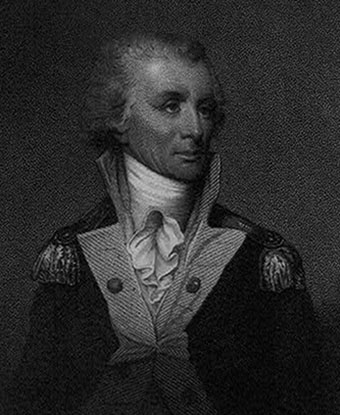Last updated: January 29, 2025
Person
Thomas Sumter

Library of Congress
Thomas Sumter, the namesake of Fort Sumter, was a patriot general during the American Revolution. Born in Virginia in 1734, his first military experience came with the Virginia militia during the Cherokee War, 1759-1761. In 1762, he accompanied the Cherokee leader Ostenaco to London where the chief had an audience with King George III. After returning to Virginia via Charleston, he was imprisoned for indebtedness but escaped and fled to South Carolina.
Sumter then settled in Orangeburg County near the Santee River and opened a country store. The venture prospered, and Sumter quickly accumulated wealth. In 1767, he married Mary Cantey Jameson, a wealthy, crippled widow eleven years his senior. Sumter and his wife moved to her plantation, Great Savannah, across the Santee in St. Mark’s Parish. The couple had two children.
The American Revolution again called Thomas Sumter to serve. After being elected a delegate to the First and Second Provincial Congresses, Sumter participated in the Snow Campaign (December 1775), the Battle of Sullivan’s Island, the Cherokee campaign (July-October 1776), and actions in Georgia (1777 - 78). On September 19, 1778 Sumter left the army and returned to private life. He was in retirement when Charleston fell to the British in May 1780. It was at this stage of the war, when patriot fortunes in South Carolina were at their lowest, that Sumter made his greatest contribution.
Thomas Sumter rallied the cause after the fall of Charleston and the defeat at Camden in 1780. He also had a personal desire to pay back the British for the burning of his plantation in the High Hills of the Santee River. He took the field, leading South Carolina militia against the British, before Maj. Gen. Nathanael Greene arrived to coordinate American resistance and to rebuild the Continental Army.
Sumter commanded South Carolina militia in many battles, including the Battles of Hanging Rock, Fishing Creek, Fishdam Ford, and Blackstock’s Plantation, where he was severely wounded. At the Battle of Blackstock’s Plantation in November 1780, Sumter dealt Lt. Col. Banastre Tarleton’s British Legion their first defeat. British military occupation of South Carolina was never firmly established given the efforts of partisans like Brig. Gen. Thomas Sumter.
Injured for several months, Sumter returned to action in February 1781 and led his men in additional encounters at Fort Granby and Orangeburg. Sumter’s pride made him ill-suited to accept command from others. Sumter never proved very cooperative with Maj. Gen. Nathanael Greene’s Continental Army. Sumter finally resigned in February 1782 as victory seemed more assured and frustrations over militia reorganization plagued him.
The remainder of Sumter’s public life was spent in politics. He served eight terms in the General Assembly between 1776 and 1790. Elected by Camden District to the US House of Representatives, he served five terms in Congress between 1789 and 1801. Sumter then served in the US Senate until 1810. Sumter was a dedicated Jeffersonian, who remained devoted to his backcountry republican values.
He was the last surviving American general of the Revolution, dying in 1832 at the age of ninety-seven. The year of 1832 also featured a sharp rise in states’ rights rhetoric, which centered around South Carolina’s opposition to the tariff and boiled into the Nullification Crisis. The Nullifiers of 1832 were among the most prominent Fire Eaters in 1860 - 1861, advocating for and realizing their dream of secession and a southern confederacy, leading to the outbreak of the Civil War at Fort Sumter.
